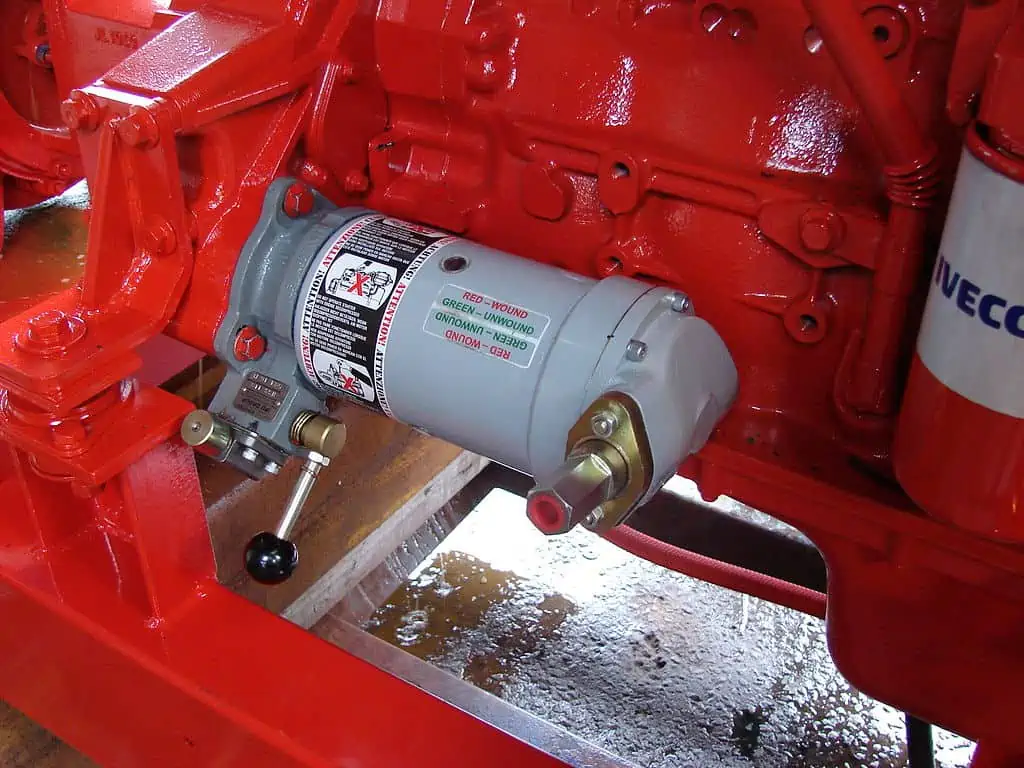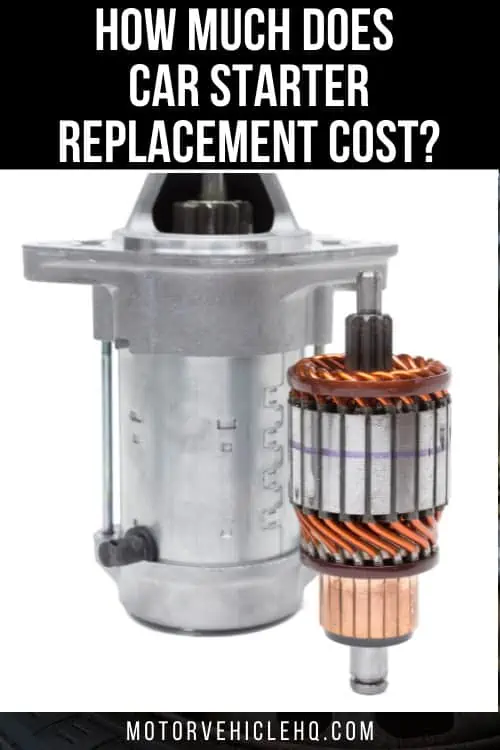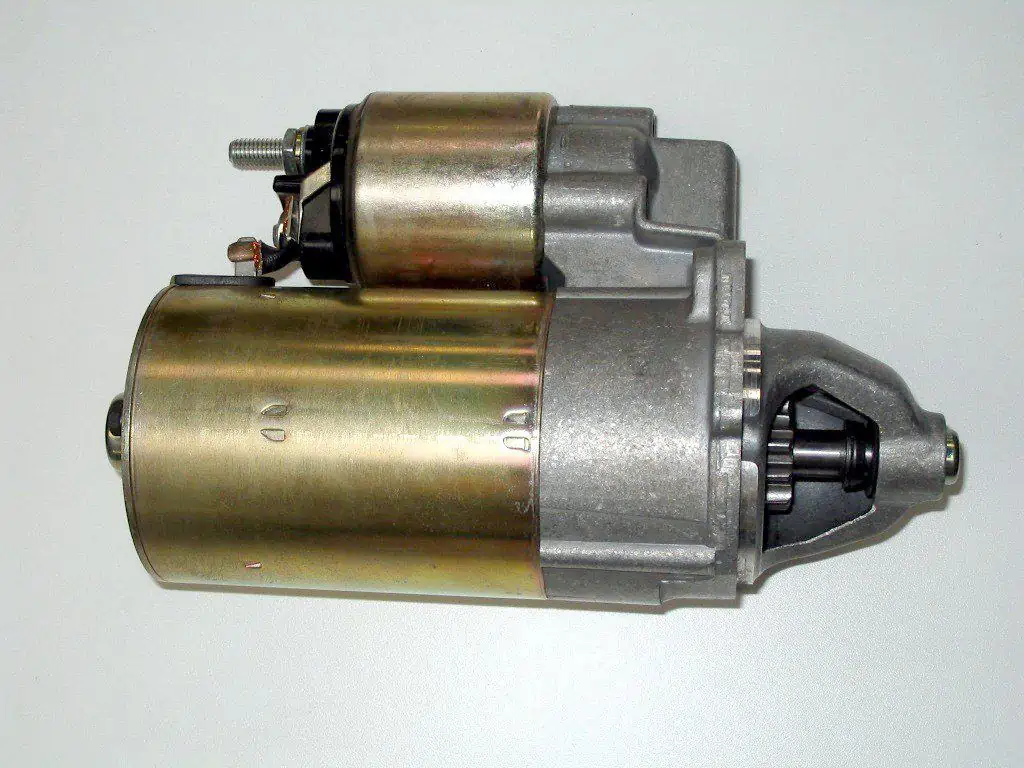A vehicle starter is a strong electric motor that starts your vehicle by cranking the engine. The motor as well as the solenoid linked to it make up the starting system.
The solenoid is responsible for delivering battery power to the starting motor. It also moves this starter gear forward, enabling it to connect with the flywheel’s gear teeth.
To start the car, a significant amount of current is required, thus your battery must have enough energy to allow the vehicle starting mechanism to function correctly.
When a car won’t start even when the battery is completely charged, the starting motor is usually to blame. Starters do wear out over time. When this happens, a car starter replacement cost is usually inevitable.
Starters can go bad for a variety of reasons. This can be caused by worn brushes, poor bearings, and a variety of other issues, many of which will want the assistance of a mechanic to identify correctly. Your starter may be diagnosed and repaired by a professional mechanic.
A malfunctioning starter will start to exhibit some of these early signs. There is a single click or nothing happens when starting a car with a fully charged battery. Even though there is 12-Volt electricity at the starter control terminal, the starter motor does not run.
Another sign is when the starting motor operates, but the engine does not turn over. When you start the automobile, you may hear a loud screeching noise. Of course, broken teeth on the flex plate or flywheel’s ring gear might also be to blame.
This article focuses on the car starter replacement cost for both professional examination in your local area and the DIY fix if you have prior knowledge about it. It will help you determine which way fits your budget in fixing the malfunctioning starter.
How Much Does Car Starter Replacement Cost?
Repairing components for a starter may cost anything between $60 and $360. A brand-new starter may set you back anything from $90 to $360. A trained mechanic may repair or rebuild the starter for anything from $160 to over $1,200.
Automobile starter by Willdre / CC BY-SA 3.0
These values vary widely depending on the extent of the issue and the brand, model, and year of your vehicle. Many vehicles have a simple starter that can be uninstalled and changed in about an hour, while others are substantially more difficult. They can be tucked away behind other engine parts like the intake manifold.
If you choose to do it yourself, a full starter replacement is a wonderful DIY job for those who have the appropriate tools and abilities.
The Starter Replacement Cost Broken Down
When the Specialists Examine the Situation
If you take your vehicle to the neighborhood auto dealership a starter replacement cost is between $260 and $410, depending on a few factors.
- At the local dealership: The overall labor rate which makes up the starter replacement cost differs significantly across states and counties. Maine, Michigan, Wisconsin, and Vermont are the cheapest states for auto repairs, followed by Ohio, Michigan, Wisconsin, and Vermont. The most expensive states are the District of Columbia, Connecticut, California, Georgia, and New Jersey (in descending order).
- Your vehicle’s make and model: The more popular the vehicle, the less costly the components will be, hence significantly lowering your starter replacement cost. It all comes down to supply and demand. The more you can find of a particular automobile part (in this instance, the car starter), the less it will cost.
The overall starter replacement cost of the new, high-quality starter is $160, according to a few various parts of websites and retailers.
Labor expenses should be low because it’s a short task that shouldn’t last more than an hour, around $90, give or take. The overall starter replacement cost, including taxes, is around $240.
These statistics are only anticipated to climb whenever it pertains to other, less regularly seen vehicles.
Another big advantage of hiring professionals to conduct the task for you would be that the services are protected by insurance, which should cover any issues that arise.
To be safe, acquire a warranty before any repairs are performed.
The Do-It-Yourself Technique
It may be less expensive to replace the car starter on your own. The reduced starter replacement cost is due to the lack of labor costs, and you will only be liable for the part cost.
The cost of a replacement starter is $160 including taxes. As a result, you should expect to pay roughly this much for it.
Hydraulic Starter by Brandon1975 / CC BY-SA 3.0
With only a few tools, one can easily remove the old starter and then replace it with the new one. A 3/8 inch or 1/4 inch drive ratchet with extensions should suffice.
In rare situations, you may additionally need a torch or headlamp, as well as the capacity to raise the vehicle off the ground. As a result, you’ll need a jack and axle supports, as well as accessibility to a hydraulic ramp or the inspection pit.
What Does It Take for a Mechanic to Replace a Starter?
The following are the stages required in replacing a starting motor:
- The vehicle battery is securely removed once the ignition is turned off and the negative battery wire is disconnected first, followed by the positive battery cable.
- They’ll then find your vehicle’s starter and remove all of the anchoring bolts that keep it attached to the engine block.
- The starting motor wire will be unplugged once the battery terminals have been detached and the mounting bolts have been removed.
- The faulty starting motor will then be removed from its current placement.
- The new starter will then be installed, and all of the bolts holding it in place will be tightened.
- The mechanic will next safely reconnect the automobile batteries, first connecting the positive battery cable and then the negative battery cable.
- The mechanic will turn on the ignition switch and listen for any strange noises or potential problems after tightening all bolts and reconnecting the car battery.
Which Factors Influences Your Vehicle’s Starter Replacement Cost?
The very first task is to identify whether a starter is to blame for your car’s inability to start.
Because so many components of the starting system are linked, your problem might be caused by a variety of electrical or mechanical issues unrelated to the starter. The symptoms might also be caused by an old battery.
You may help yourself by identifying the broken part, or a professional can compare the cost of repairing or replacing the starter.
A rebuilding job can take a very long time, while a replacement job only requires installing a new starter and then tightening the bolts to OEM torque specs.
The starter replacement cost is typically determined by the year, brand, and model of the vehicle. Total labor expenses may also differ depending on your location.
A starter replacement cost for a Honda Accord, for instance, is around $440. This cost, however, might vary depending on the Honda Accord model you have and where you live.
The price of a new vehicle starter is impacted by whether or not the vehicle requires a new ring gear. When the ring gear seems to be necessary, the total cost of repair should be around $190.
Furthermore, the location of the vehicle starter might affect starter cost estimations. Most cars’ starters are easily accessible, while some starters are located around difficult-to-reach engine components, such as beneath the vehicle’s intake manifold.
What Makes a Starter Complete?
Various fundamental pieces make up a starter. Knowing the internal parts of a starter may allow you to determine whether you repair or replace it, which can impact the cost of the service. The following are the major components of an automobile starter:

- The permanent magnets or electromagnetic field coils
- The commutator and armature
- The solenoid
- The shift fork
- The starter drive gear
- The brushes
- The bearings and bushings
The starting housing houses the electromagnetic field coils. You may have two to four field coils depending on your car. These are powered by the armature to spin over the engine and are electrified by your car’s battery.
The armature is a long-lasting component that is supported by a shaft and bearings. Conductor loops are wrapped around the armature to transmit electricity and maintain electrical contact while it rotates.
A starting solenoid consists of a moveable core and two-wire coils. It controls the electrical circuit and activates the starter by turning it on and off.
A plunger linked to the solenoid controls the shift fork, which is connected to the starting drive gear, to turn the engine over when engaged on starters with an integrated solenoid.
Starters are available in a variety of sizes and patterns. Not all starters are created equal, and the placement of your beginning may differ. Before purchasing a starting or starter rebuild kit, always examine your owner’s handbook.
What are the Symptoms of a Failing Starter?
On the surface, it might be difficult to tell the difference between battery and starter difficulties. Even though the ignition switch attached to the key can sometimes fail, this is a much less typical occurrence.
It’s more frequently than not the battery, not the starter, that’s at the source of the problem. You should acquire a battery tester to exclude the battery.
When you attach it to your battery, it will provide you with measurement and an estimate of the battery’s status, and whether or not it requires to be replaced.
Advanced battery testers can also tell you about your alternator as well as the starter. Should you experience one of these, it’s unquestionably worthwhile to check these out while you’re at it.
If your vehicle isn’t starting properly, you’re likely to uncover a problem that points least to either of these components.
You may observe the following:
- Nothing occurs whenever you start the engine; no click, no nothing.
- When you insert the key and set it to START, there is a slight click but no additional sound.
- You may hear a delayed variation of the “rrr – rrr – rrr” noise that normally occurs when the vehicle starts. The engine may still start, but it will be difficult to do so.
- Once the engine is started, it makes a grinding, crunching noise.
No Noise
If nothing happens after you’ve checked the battery and everything else (lights, radio, etc.) is in working order, something is likely wrong with the starting wire or the solenoid.
Wires can get frayed or become loose for a variety of reasons. Any issues here might cause the circuit to be disrupted, preventing the electricity from reaching the starter.
A short circuit is also possible, albeit this is even more likely to occur during installation instead of years after the item has been used.
Driver starting the engine of a car by Yonkers Honda / CC BY-SA 2.0
The lack of a “click” sound also means the pinion isn’t pushing out to be level with the flywheel, and the plunger isn’t operating within the solenoid.
The solenoid will not complete the connection with the rotor, since it is not moving. As a result, the pinion will not rotate or travel outward.
The solenoid might be the source of the problem in this scenario. Electromagnet problems might be difficult to solve since they are precision-engineered components. While it may be feasible to repair the part manually, replacing the entire unit may save you time.
Only One Small Click
We’re referring to when you turn the key and just hear a small tap or click, no “rrr – rrr – rrr”, the engine doesn’t crank or turn over.
The click might be caused by several factors, but in the case of starting motors, the most likely source is the movement of the solenoid’s plunger and, as a result, the pinion gear.
The pinion gear is pushing out to contact the flywheel, but it isn’t rotating. As a result, you won’t hear the typical startup noises.
All of this indicates that there is an issue with the solenoid or the motor itself.
If you hear the motor spinning – a whirling sound identical to a blow dryer, but nothing happens, there might be a problem with the starter’s gearing mechanism.
However, if you understand what you’re doing and have the right tools, you might be able to fix a starter that’s exhibiting these symptoms. If in doubt, though, replacing it is typically the easiest and most cost-effective option.
Cranking at a Slower Rate
In these circumstances, the starting motor’s pinion gear engages with the flywheel and effectively turns it… but with less torque than usual. As a result, we may determine that the issue is with the starter’s power supply.
In most cases, this problem is caused by a lack of voltage or a lack of electrical energy to power the starter. If the battery appears to be in good condition, the problem is most likely due to a faulty wire connection or loom.
If this does not work, the motor itself might be the source of the problem.
To locate the problem, you’ll need specialized knowledge and electrical equipment, just like in the prior examples. It’s possible that just a starter replacement would save you a lot of time.
Crunching and Grinding
Assume you hear a grinding or crunching sound. This indicates that the pinion gear is not correctly engaging (or disengaging, depending on when you hear it) with the flywheel.
There might be worn teeth on the pinion gear or the flywheel. A broken connection between the plunger and the pinion might be causing the noise.
If the noise continues, it will cause damage to both the starter and the flywheel. When replacing or repairing the starter, look for substantial damage to the flywheel.
If it’s lacking a lot of teeth, you may need to replace it as well, or the new starter won’t be able to connect with it.
Unfortunately, since the flywheel is coupled to the crankshaft and requires extensive disassembly, the cost of a flywheel replacement is far higher than that of a starter, between $500 and $1,000.
Engine Start Stop Button by Motor Verso / CC BY 2.0
To avoid paying exorbitant fees, have your starter repaired or replaced as soon as you notice grinding noises.
Is It Possible for Me to Drive with a Malfunctioning Starter to Avoid Starter Replacement Cost?
Driving a car with a defective starter will not harm the vehicle as long as it is running. If you drive your automobile in this situation, though, you may become stranded.
When you get to your destination, you usually turn off the automobile. You might not be able to crank the car when you’re ready to depart if you have a faulty starter.
There aren’t many things you can do to get an automobile going again if it has a faulty starter.
You might be able to get the starter functioning again by softly tapping it with a hammer in certain circumstances, but don’t bank on it. Because of these factors, you should get a starter replacement as soon as possible.
Conclusion
Worn or burnt solenoid connections, worn brushes as well as a commutator, and damaged armature bushings are the most common causes of starting issues.
Whenever the solenoid clicks but the starter does not start the engine, this is a sign of worn-out solenoid connections. The starter makes no noise when the starter brushes are worn out.
The armature scrapes against the field shoes when the front and rear armature bushings wear out, causing the starter to operate slowly and loudly. Instead of bushings, many new starting motors use tiny ball bearings.
It might be an indication of starter failure if your vehicle won’t start or makes strange noises whenever you switch on the ignition system.
Consider incurring a starter replacement cost to obtain a new starter or repair as soon as possible if this happens. Remember that the sooner you handle the issue, the cheaper your starter cost may be.


Jim Wicks is the founder of MotorVehicleHQ. With over two decades of experience in the automotive industry and a degree in Automotive Technology, Jim is a certified car expert who has worked in various roles ranging from a mechanic, car dealership manager, to a racing car driver. He has owned more than 20 cars over the past 15 years. Ask him about any vehicle you see on the road and he can tell you the make, model and year. He loves the aesthetics of all things cars, and keeps his vehicles in pristine condition.
In his free time, Jim enjoys getting his hands dirty under the hood of a classic car or taking long drives along the country roads. His favorite car? A 1967 Shelby GT500, a true classic that, according to Jim, “represents the pure essence of American muscle.”




